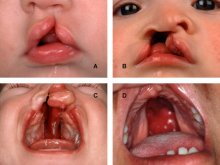Cleft lip and palate repair

- Worldwide incidence of cleft lip and palate is 1 in 800 live births. In India, incidence is 3.6 in 1000 births. United States : 1:750, Asia: 1:500, Caucasians: 1:1000, male: female 2:1.
- 32% of clefting deformities are the isolated cleft lip.
Pathogenesis
The primary palate or premaxilla is a triangular area of the anterior hard palate extending from anterior to the incisive foramen from point just lateral to the lateral incisor teeth. It includes that portion of the alveolar ridge containing the four incisor teeth.
The secondary palate consists of the remaining hard palate and all of the soft palate. The clefts result due to interference with the embryological development.
Facial development (Weeks 4 to 8)
- Fourth and fifth weeks: Mandibular processes fuse to form mandible and lower lip.
- Fifth week: Frontonasal process grows downwards to form the: (a) median nasal process, and (b) lateral nasal process.
- Fifth to eight weeks: Median nasal processes fuse with the maxillary processes to form the premaxilla and upper lip.
Development of secondary palate (Weeks 8 to 12)
- Two palatal shelves grow downward from the maxillary processes. Until now there was no separation of the oral and the nasal cavities.
- In weeks 8 and 9, there is a rapid development of the mandible so the tongue is pulled away from the palatal shelves.
- The palatal shelves fuse (starting from the anterior to the posterior direction). The fusion involves degeneration of epithelium at the areas of contact and penetration of mesoderm. This separates the oral and nasal cavities. Hard palate develops first, soft palate later (around 10th week).
- The nasal septum grows downwards and fuses with the palatal shelves in the midline. This separates the right and left nasal cavities.
Pathogenesis of clefts
- Cleft lip-results from a failure to maintain an epithelial bridge due to lack of mesodermal delivery and proliferation from the maxillary and nasal processes.
- Cleft palate-failure of decent of the tongue, failure of mesodermal migration into palatal shelves, delay of mesodermal migration into palatal shelves are the possible causes for left palate.
Aetiology of cleft lip and palate
The various factors responsible for cleft lip and palates are:
1. Maternal infection and toxicity
- Infection-rubella, influenza
- Toxicity-hypoxia, teratogenic drugs like valium, phenytoin, corticosteroids, cytotoxic drugs like nitrogen mustard.
2. Maternal dietary imbalance
- Folic acid deficient diet
- Hypervitaminosis A
3. Maternal hormone imbalance
Any imbalance in maternal hormone concentrations at the time of conception is suspected to produce cleft lip and palate.




